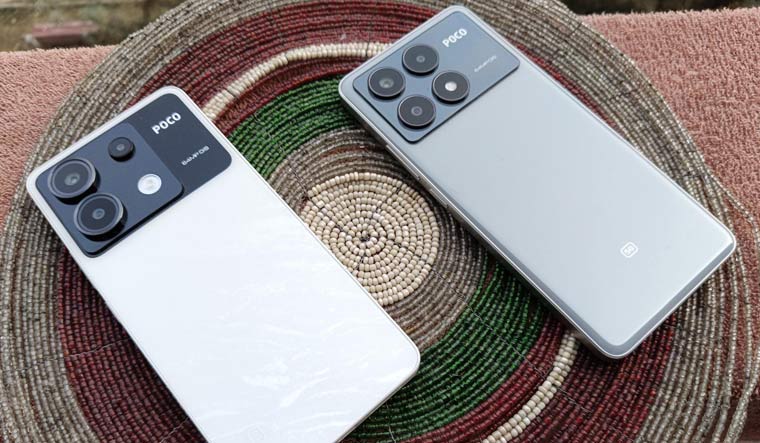Poco has been a name often associated with value in the smartphone world. The company's F5 was one of the better and more affordable options available last year. This time, Poco has launched the X6 Pro, priced at ₹26,999 for the base model, and the X6 starting at ₹21,999. Do they have what it takes to compete in these price segments? Let's try to find out.
Design: Both the Poco X6 and X6 Pro are made of polycarbonate materials with smooth edges and slightly curved backs towards the borders. The Poco X6 has Gorilla Glass 5 on top of its 6.67-inch display, while the Poco X6 Pro has Gorilla Glass Victus protection. On the right side, you'll find the volume buttons and power/lock keys, which are tactile enough. The left side is plain with no buttons or ports. The top features an infrared port, an outlet for the loudspeaker, and a secondary microphone. The Poco X6 also includes a 3.5mm audio jack. At the bottom, you'll find the primary microphone, the USB Type-C port, and another outlet for the loudspeaker. The back of both Poco X6 and Poco x6 Pro houses the camera setup, which is placed in a rectangular cutout. While some people may not like this cutout, I don't believe it's a major deal breaker. Both phones weigh less than 190 grams, with the Poco X6 Pro being slightly heavier. They both measure around 8mm in thickness, with the Poco X6 Pro being slightly thicker. Neither phone has any creaks or alarming bends, and they don't feel cheap in the hand. The Poco X6 comes in black, white, and blue colors, while the Poco X6 Pro is available in black, grey, and yellow, featuring a vegan leather back.
Display: You get 6.67-inch displays in both phones, with support for 120Hz refresh rates. The Poco X6 Pro probably has the best display used by Poco in a phone so far, in terms of brightness, color calibration, and contrast. Both phones support Dolby Vision playback under Netflix, where the extra bits of brightness come in handy for handling shadow scenes and contrast in general, better than Poco's previous phones.
Camera: These phones come with a triple camera system, consisting of a 64MP (f/1.7) main camera, an 8MP (f/2.2) ultra-wide camera, and a 2MP (f/2.4) camera. The HDR effect can be turned on to capture sharp and contrast-y looking photos, especially on the Pro model. In low-light conditions, the phone can deliver okay shots as long as there is no movement from both the user and the subject. Switching to 64MP shots doesn't cause much stutter, and there is not a significant shutter delay. Portrait shots are in line with the F5, with slightly enhanced skin tones. The front-facing 16MP (f/2.4) camera can take decent portrait shots in daylight and regular shots in less than ideal lighting conditions when using the Night mode. Overall, these phones offer some of the better camera combinations available in their price ranges today.
Performance and software experience: While the Poco X6 Pro is powered by the MediaTek Dimensity 8300 Ultra chipset (up to 3.35GHz octa-core processor, Mali-G615 GPU) along with 12GB LPDDR5X RAM and 512GB UFS 4.0 storage (also available in the 8GB + 256GB option), the Poco X6 is equipped with the Qualcomm Snapdragon 7s Gen 2 chipset (up to 2.4GHz octa-core processor and Adreno 710 GPU) alongside 12GB LPDDR4X RAM and 512GB UFS 2.2 storage (also available in 8GB + 256GB and 12GB + 256GB configurations).
The Poco X6 Pro comes with HyperOS 1 based on Android 14 with the December security patch out of the box, while the Poco X6 runs on MIUI 14 for Poco that's based on Android 13.
In terms of performance, the Poco X6 Pro can handle games like World War II at its highest settings or BGMI at 90FPS with HDR enabled, experiencing very few frame drops and no major heating issues even after playing for 30 minutes or so. However, the battery drain should be watched out for. On the other hand, the Poco X6 may not be able to handle such games at high settings, but it can provide smooth gameplay for games like Asphalt 8 and Badland.
Both phones perform well in day-to-day tasks, including switching between apps and animations. HyperOS seems to have improved memory management compared to MIUI, and it also offers enhanced theming options. It's worth mentioning that Poco promises 3 major OS updates and 4 years of security updates for these phones.
Battery: The Poco X6 features a 5,100mAh battery unit, while the X6 Pro has a 5,000mAh battery unit. Both batteries last about 22-24 hours on average with similar workloads at auto refresh. This workload includes two email accounts, display brightness set at about 35%, 5G usage for approximately 90 minutes, and a lot of web browsing. The phones charge from 1% to full in around 50 minutes using the 67-watt bundled chargers.
Other aspects: The 5G network reception is pretty good, especially on the Poco X6 Pro, even while working on the go. Both phones have clear and sufficiently loud loudspeakers for video and gaming use. GPS, WiFi, and Bluetooth performance didn't show any unusual glitches during my usage. The in-screen fingerprint scanner is quick enough, although we have seen better ones at a similar price range in terms of reliability, but the difference isn't significant.
Verdict: The X6 Pro seems like another great value for money option from Poco, especially for those who want to play games on their smartphone. It is available under Rs. 30,000 and can also take good shots while not disappointing in the battery department. The Poco X6, although not as impressive, is also a pretty good offering with a decent design, capable cameras, and 5G connectivity.



